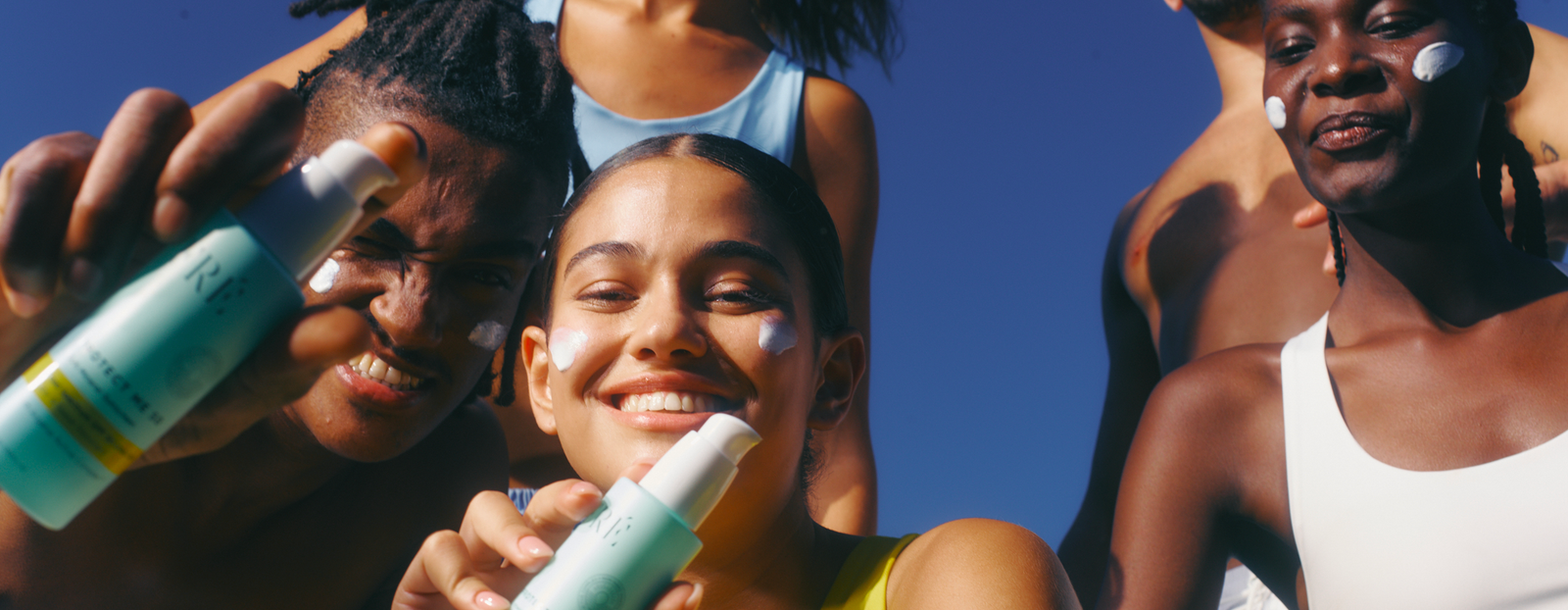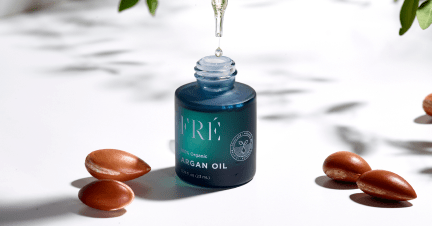Shop All
ABOUT FRE
Meet Argania Active Complex™ (AAC). Our unique patented formula, designed for your active life.
Wear Mineral Sunscreen, Every Day, Everywhere
by Lorisa Hasenbush December 31, 2023

Did you know that UV rays are harmful all year round, not just in the summer months? Clouds do not protect you from UV rays; in fact, 80% of UV rays penetrate cloud cover on a cloudy day. Snowy days are doubly dangerous, because snow reflects UV rays, doubling your exposure. In addition, the stratospheric ozone layer, which absorbs ultraviolet light, protecting life on Earth, is the thinnest in the northern hemisphere in the fall. This means that people living in North America and Europe have less natural UV protection from the ozone layer from September to March, so there is more exposure to UV rays.
Remember that the time of day also affects UV rays. The sun's rays are strongest between 10 a.m. and 4 p.m., even in winter. It is best to seek shade during these peak hours if possible.
Even if you spend most of your time indoors, you can be exposed to UV rays. More than 50% of UVA rays can penetrate glass, so if you spend time near a window, you are still susceptible to sun exposure.
UV rays damage skin
Now you might wonder, how much damage can UV rays really do to your skin? There are two types of UV rays that affect your skin. UVA rays have longer wavelengths. Approximately 95% of ultraviolet rays that reach the Earth’s surface are UVA rays. These rays penetrate deep into the layers of the skin and damage collagen fibers and elastin production. As a result of cumulative exposure to UVA rays, skin can look leathery and wrinkled. UVB rays are high energy, shorter wavelengths. UVB rays penetrate only the top layer of skin and cause sunburns. Both UVA and UVB rays can cause skin cancer.
Cumulative exposure to UVA rays can make skin look leathery and wrinkled.
Photoaging begins in childhood when skin is overexposed to sunlight. Since the damage happens in the deeper layers of the skin, you do not see signs of damage right away. Skin cell DNA and collagen fibers are damaged, and as a result, skin is rebuilt incorrectly, forming wrinkles. Unfortunately, as you age, UV damage accumulates and becomes visible, appearing on the skin as wrinkles, lines, dark spots, sagging skin, etc. These changes in the skin are known as “signs of aging.” But in truth, 90% of visible changes to the skin are caused by UV rays, not the number of birthdays you have celebrated.
Preventing photoaging
Thankfully, there is a simple way to protect your exposed skin from UV rays all year round and prevent cumulative UV damage: SUNSCREEN! Available in lotions and sprays, sunscreen shields your skin from sun exposure. By applying sunscreen daily, you can protect your skin from absorbing UV rays and suffering from sun damage. Here are some tips for choosing the right sunscreen.
Broad spectrum
Make sure your sunscreen is broad spectrum, meaning it protects from both UVA and UVB rays. If it only protects from one type of UV rays, your skin is still at risk.
Sun Protection Factor
Apply sunscreen with Sun Protection Factor (SPF) of 30 or higher. SPF measures how much UV radiation is required to produce sunburn on protected skin. The amount of solar exposure depends on many factors, including the UV intensity, the time of day, and the geographic location. For example, one hour in the sun at 9:00 can have the same amount of exposure to solar energy as 15 minutes in the sun at 1:00 p.m. As the SPF value increases, sunburn protection increases. Since all sunscreens wear off and become less effective with time, it is important to reapply sunscreen at least every two hours.
Water resistance
Water resistant sunscreen is essential, so it will not drip off as you sweat or be washed away quickly if you are participating in water activities. Keep in mind that water resistant sunscreens have a limited duration of protection, so be sure to reapply as necessary.

Mineral sunscreen
There are two main types of sunscreen: mineral and chemical. Both types provide sun protection, but the active ingredients work differently. When using chemical sunscreens, the skin absorbs the active ingredients and a chemical reaction is created to block UV rays. Research shows that the active ingredients in chemical sunscreens are absorbed into the bloodstream and remain in the body for extended periods of time. Since the active ingredients in chemical sunscreens are absorbed through the skin, the FDA says there is insufficient data about their safety and is requiring the collection of additional data on the twelve active ingredients in chemical sunscreens in order to fully understand their effect on the body in short- and long-term.
Mineral sunscreens, on the other hand, contain zinc oxide or titanium dioxide as their active ingredients. Both of these ingredients are considered safe and effective by the FDA. Mineral sunscreen sits on top of the skin, physically blocking UV rays. The active ingredients are not absorbed into the skin or the bloodstream.
The FDA considers zinc oxide and titanium dioxide, active ingredients in mineral sunscreen, safe and effective for UV protection.
Mineral sunscreen has many benefits beyond not entering the bloodstream. Since it sits on top of the skin, it is less likely to cause irritation or allergic reactions, making it an ideal choice for those who have sensitive skin. As mineral sunscreen physically blocks UV rays, it starts working as soon as it is applied, unlike chemical sunscreen that has a waiting time until it is effective. In addition, mineral sunscreen is safe for coral and marine life, whereas research has shown that the active ingredients in chemical sunscreen harm coral reefs and contribute to coral bleaching.

FRÉ understands clean suncare
All of FRÉ’s sunscreens contain non-nano zinc oxide, which provides broad spectrum mineral UV protection. Non-nano zinc oxide is not absorbed through the skin or the bloodstream, so you do not have to worry about side effects. The formulas also are enriched with FRÉ’s patented Argania Active Complex™, a breakthrough antioxidant complex that treats sun damage and photoaging. In addition, FRÉ sunscreens are lightweight, water resistant, and rub into skin without leaving a white cast. They are a great addition to any skincare routine, providing daily UV protection.
Apply sunscreen every day of the year
Whether you can see the sun shining or not, you are exposed to UV rays every day of the year. Applying broad spectrum SPF 30 mineral sunscreen, like PROTECT ME, every day is the best way to prevent photoaging and to let your skin glow and age well. PROTECT ME provides mineral UV protection with non-nano zinc oxide, and its ultralight formula does not leave a white cast. Use PROTECT ME daily to enjoy a youthful, glowing complexion and UV protection.

Leave a comment
Comments will be approved before showing up.






